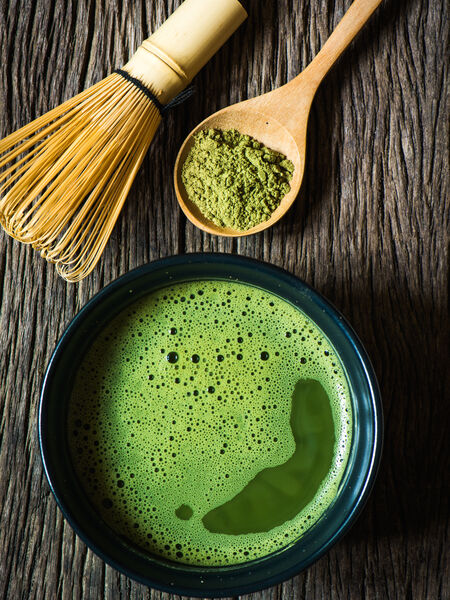Omotesenke’s Pond Style: Matcha Whisking Tips

If you’re a Matcha enthusiast then you’ll no doubt be used to preparing your Matcha in a very specific way: aiming for a thick and creamy froth atop your dark green sea of umami goodness.
But did you know there is another method you could use to prepare your Matcha that focuses much less on the froth? It’s called the "pond" style whisking method and it’s the whisking method most commonly used and taught by the Omotesenke school of tea.
I learned this method through a friend who is studying under the Omotesenke school of tea and the first time I tried it out I was so shocked when I took the first sip of the bowl I had prepared! It was so different from what I would normally expect from Matcha. I wanted to share it with you all and pass on the knowledge she shared with me to hopefully open you up to a whole new experience with Matcha.
Omotesenke vs. Urasenke Schools of Tea
For those of you who aren’t familiar with the schools of Japanese tea, Omotesenke is the second biggest school of the Japanese tea ceremony.
The Omotesenke school of tea was established by Koushin Sousa (Kōshin Sōsa) (1613-72), who also inherited the teahouse named Fushinan. The current head of Omotesenke-Fushinan-foundation is Lemoto Sōsa Jimyosai. The name Omotesenke comes from the following Japanese: "Omote" comes from the location of the Fushin-An teahouse which faces the front and main street. In Japanese, "front" is called "Omote". The "Senke" part as in both Urasenke and Omotesenke means the "house of sen".
There are some differences in the way that the tea ceremony is performed by Urasenke and Omotesenke. For example, Urasenke whisks the Matcha quickly and the aim is to produce a thick, creamy foam with very small bubbles that sits atop the tea while you sip. While Omotesenke do not whisk the Matcha anywhere near as much, they still have foam in their matcha but the aim is to have about 50% foam and 50% not foam, producing windows into the tea and creating what looks like a pond or a lake, hence the name pond style whisking.
Omotesenke uses Susudake, which is smoked-bamboo or darkened-bamboo for its Chasen, while Urasenke prefers to use blank, untreated bamboo for its Chasen. Some people say that Urasenke likes to display its most expensive and valuable utensils to impress its guests. Utensils made by famous craftsmen or expensive brand tools are said to be preferred by Urasenke. Omotesenke however, prefers to keep things simple and plain. This doesn't mean that cheaper low quality materials are used but that a little more thought has been given to balance between the various utensils so that each one of the items used is given an equal amount of attention and not one of them is overlooked by the guest.
Make Pond Style Whisked Matcha
In order to make pond style Matcha, first sift your Matcha to prevent clumps. Then add 85ml of water to your Chawan to warm it up and also take your Chasen and soak it in the water for a little bit. This will stop the prongs from breaking and make them more malleable. Warm the bowl up by turning the bowl gently to make sure all parts of the bowl are warm, then dry the bowl afterwards.
Take your Chasaku and put 2 scoops of Matcha into your Chawan, tapping it on the side of the bowl twice to make sure you have all of the Matcha off. Add in your water, take your Chasen and whisk the Matcha in an “M” shape, but be slow and gentle with it, because you aren’t looking to build a froth like usual, you just want to incorporate the tea into the water. Once you have 50% foam and 50% not foam, then take your Chasen and do one big circle before taking it out, this will help produce the little pond shapes in the foam ,sometimes turning into two koi shapes.
This is not the full ceremonial way to prepare this Matcha, but unless you are studying under the Omotesenke school, knowing every step of the traditional ceremony is not something you really need to worry about. I recommend researching about it though, so you can compare the differences between the schools of tea, the methods they use. The way I've listed above is perfect for everyday preparation and not too complicated.
This method is best suited to Usucha (thin matcha) and results in a richer flavor, with a more intense but beautiful full and complex profile overall.
For a Matcha enthusiast, this is a great option for the Matcha tool belt and helps to give perspective on what makes good Matcha. It will help you get out of the mind set that good foam equals good Matcha, which is what most people these days bring it all down to. This puts way too much focus on the foam, giving people new to tea the wrong idea from the very start of their journey. If you’ve never used this method of preparation before, this slight push outside of your comfort zone will help you to get something a little more meaningful from your Matcha overall.
Each style has its own benefits and I myself use both when preparing Matcha. Traditionally, it just really depends on what you are wanting from your session, or if you are studying under one of the schools of tea you’ll more than likely use one method more than the other. Again, I recommend learning more about the schools of tea and trying to implement their concepts and perspectives into your daily tea practice. Doing so will help you feel much more connected to the tradition and history behind Chado and may even aid you in your meditative practices.
